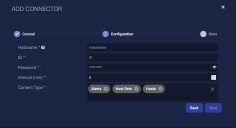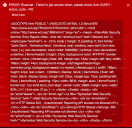Configuring Trellix (FireEye) Endpoint Security HX Connectors
This connector allows Stellar Cyber to ingest logs from FireEye (Trellix) HX and add the records to the data lake.
Connector Overview: Trellix (FireEye) Endpoint Security HX
Capabilities
-
Collect: Yes
-
Respond: No
-
Native Alerts Mapped: Yes
-
Runs on: DP
-
Interval: Configurable
Collected Data
|
Content Type |
Index |
Locating Records |
|---|---|---|
|
Alerts Hosts Hosts Sets |
|
Domain
|
https://<Hostname> where <Hostname> is a variable from the configuration of this connector |
Response Actions
N/A
Third Party Native Alert Integration Details
Stellar Cyber identifies the FireEye data logged into the Syslog index. Records of the type Alerts are then normalized, enriched, and mapped to the Alerts index. The following fields are included as part of the Stellar Cyber alert description: indicator.name and agent.url. Each relevant Syslog record is compared against existing records in the Alert index and not added to that index if the values in the following fields match those of an existing record logged in the previous 24 hours: org_id, tenantid, user.name, host.ip, event.name, file.path, process.path.
The following four alert types are supported: IOC, MAL, AMSI, and PROCGUARD. Tactic and Technique are based on alert type.
For details, see Integration of Third Party Native Alerts.
Required Credentials
-
Hostname: This is your Trellix (FireEye) Endpoint Security HX host.
-
ID: This is the username with at least api_analyst role.
-
Password: This is the password for the above user.
Let us know if you find the above overview useful.
Adding a Trellix (FireEye) Endpoint Security HX Connector
To add a Trellix (FireEye) Endpoint Security HX connector:
Obtaining your Trellix (FireEye) Endpoint Security HX Credentials
Configuring your Stellar Cyber connector requires the following details from your HX deployment:
-
Hostname: This is your HX host. Example: hexbyd438-hx-webui-1.hex01.helix.apps.fireeye.com.
-
ID: This is the username at least api_analyst role. (Refer to: https://fireeye.dev/docs/endpoint/authentication/) for guidance creating this user and password).
-
Password: This is the password for the above user.
Adding the Connector in Stellar Cyber
With the access information handy, you can add the Trellix (FireEye) Endpoint Security HX connector in Stellar Cyber:
-
Log in to Stellar Cyber.
-
Click System | Integration | Connectors. The Connector Overview appears.
-
Click Create. The General tab of the Add Connector screen appears. The information on this tab cannot be changed after you add the connector.
-
Choose Endpoint Security from the Category drop-down.
-
Choose Trellix (FireEye) Endpoint Security HX from the Type drop-down.
-
For this connector, the supported Function is Collect, which is enabled already.
-
Enter a Name.
This field does not accept multibyte characters.
-
Choose a Tenant Name. This identifies which tenant is allowed to use the connector.
-
Choose the device on which to run the connector.
-
(Optional) When the Function is Collect, you can create Log Filters. For information, see Managing Log Filters.

-
Click Next. The Configuration tab appears.
The asterisk (*) indicates a required field.
-
Enter the Hostname using the information you noted above.
Do not include https in the Hostname.
-
Enter the ID you noted above.
-
Enter the Password for this ID.
-
Choose the Interval (min). This is how often the logs are collected.
Interval configuration applies to the Alerts content type. The data for Hosts and Host Sets are pulled every 24 hours.
-
Choose the Content Type. The logs for Alerts, Host Sets, and Hosts are supported.
-
Click Next. The final confirmation tab appears.
-
Click Submit.
To pull data, a connector must be added to a Data Analyzer profile if it is running on the Data Processor.
The new connector is immediately active.
Testing the Connector
When you add (or edit) a connector, we recommend that you run a test to validate the connectivity parameters you entered. (The test validates only the authentication / connectivity; it does not validate data flow).
For connectors running on a sensor, Stellar Cyber recommends that you allow 30-60 seconds for new or modified configuration details to be propagated to the sensor before performing a test.
-
Click System | Integrations | Connectors. The Connector Overview appears.
-
Locate the connector that you added, or modified, or that you want to test.
-
Click Test at the right side of that row. The test runs immediately.
Note that you may run only one test at a time.
Stellar Cyber conducts a basic connectivity test for the connector and reports a success or failure result. A successful test indicates that you entered all of the connector information correctly.
To aid troubleshooting your connector, the dialog remains open until you explicitly close it by using the X button. If the test fails, you can select the button from the same row to review and correct issues.
The connector status is updated every five (5) minutes. A successful test clears the connector status, but if issues persist, the status reverts to failed after a minute.
Repeat the test as needed.
Verifying Ingestion
To verify ingestion:
- Click Investigate | Threat Hunting. The Interflow Search tab appears.
- Change the Indices to Syslog or Assets. The table immediately updates to show ingested Interflow records.








